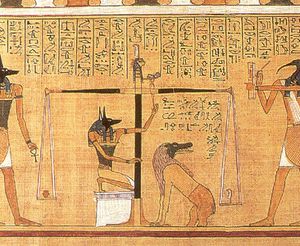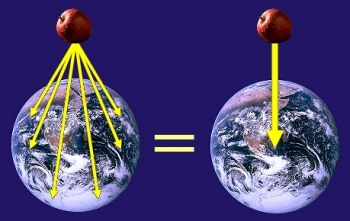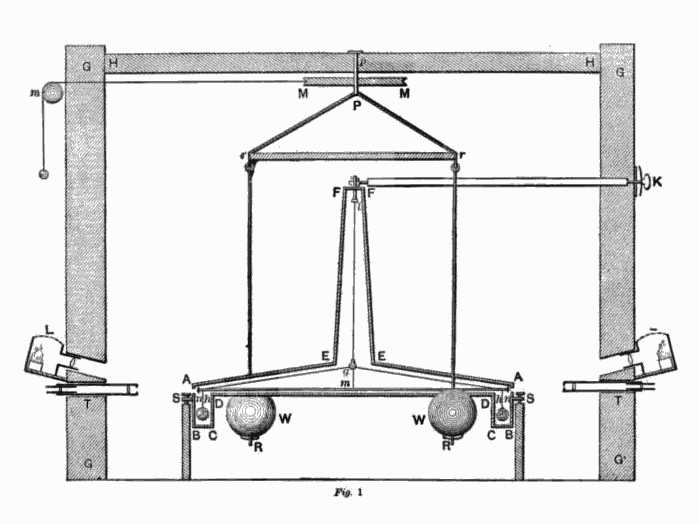Mass
In physics, mass (often defined as the "quantity of matter") commonly refers to two properties of matter which describe its response (acceleration) to an applied force (inertial mass) and its ability to generate or be affected by gravitational force (gravitational mass).
Although inertial mass, passive gravitational mass and active gravitational mass are conceptually distinct, no experiment has ever unambiguously demonstrated any difference between them. In classical mechanics, Newton's third law implies that active and passive gravitational mass must always be identical (or at least proportional), but the classical theory offers no compelling reason why the gravitational mass has to equal the inertial mass. That it does is merely an empirical fact.
Albert Einstein developed his general theory of relativity starting from the assumption that this correspondence between inertial and (passive) gravitational mass is not accidental: that no experiment will ever detect a difference between them (the weak version of the equivalence principle). However, in the resulting theory, gravitation is not a force and thus not subject to Newton's third law, so "the equality of inertial and active gravitational mass [...] remains as puzzling as ever".
In everyday usage, mass is often taken to mean weight, but in scientific use, it refers to the inherent property of matter to react intertially or engage in gravitational field production and interaction. In the International System of Units (SI), mass is measured in kilograms (kg).
Contents
Inertial Mass
The inertial mass of an bject determines its accelleration in the presence of an applied force. In classical mechanics,Isaac Newton's second law of motion, relates the force F exerted in a body of mass m to the body's acceleration a:
- F = ma
Newton's third law of motion states that if one object exerts a force on a second object, it will experience an equal and opposite force:
- FAB = -FBA
- FAB = mAaA
- FBA = mBaB
where aA and aB are the accelerations of A and B, respectively. Thus
This is, in principle, how we would measure the inertial mass of an object. We choose a "reference" object and define its mass mB as (say) 1 kilogram. Then we can measure the mass of any other object in the universe by colliding it with the reference object and measuring the accelerations.
Additionally, mass relates a body's momentum p to its velocity v:
- p = mv
and the body's kinetic energy Ek to its velocity:
Gravitational Mass
A body's mass also determines the degree to which it generates (active gravitational mass) or is affected by (passive gravitational mass) a gravitational field. If a first body of mass m1 is placed at a distance r from a second body of mass m2, the first body experiences an attractive force F given by
where G is the universal constant of gravitation, equal to 6.67×10−11kg−1 m3 s−2. This is sometimes referred to as gravitational mass (when a distinction is necessary, M is used to denote the active gravitational mass and m the passive gravitational mass). Repeated experiments since the seventeenth century have demonstrated that inertial and gravitational mass are equivalent; this is entailed in the equivalence principle of general relativity.
Kepler
Johannes Kepler was the first to give an accurate description of the orbits of the planets, and by doing so; he was the first to describe gravitational mass. In 1609, Kepler published his three rules of planetary motion, explaining how the planets follow elliptical orbits under the influence of the Sun, with the Sun at a focal point of the ellipse. Kepler discovered that the square of the orbital period of each planet is directly proportional to the cube of the semi-major axis of its orbit, or equivalently, that the ratio of these two values is constant for all planets in the Solar System. This constant ratio is a direct measure of the Sun's active gravitational mass, it has units of distance cubed per time squared, and is known as the standard gravitational parameter:
- Galileo
In the same year that Kepler published his three rules of planetary motion, Galileo Galilei demonstrated his first telescope. In 1610, four moons orbiting the planet Jupiter, the first celestial bodies observed to orbit something other than the Earth or Sun. Galileo obtained estimates for their periods and the semi-major axis of each moon, thus allowing the gravitational mass of Jupiter to be determined from the orbits of its moons. The gravitational mass of Jupiter was found to be approximately a thousandth of the gravitational mass of the Sun.
Sometime prior to 1638, Galileo showed that objects in free fall under the influence of the Earth’s gravitational field have a constant acceleration.
Hooke
Robert Hooke published his concept of gravitational forces in 1674, stating that: “all Coelestial Bodies whatsoever, have an attraction or gravitating power towards their own Centers" [and] "they do also attract all the other Coelestial Bodies that are within the sphere of their activity”. He further stated that gravitational attraction increases “by how much the nearer the body wrought upon is to their own center.”
Newton
In a correspondence of 1679-1680 between Robert Hooke and Isaac Newton, Hooke conjectured that gravitational forces might decrease according to the square of the distance between the two bodies. Hooke urged Newton, who was a pioneer in the development of calculus, to work through the mathematical details of Keplerian orbits to determine if Hooke’s hypothesis was correct. Newton’s own investigations verified that Hooke was correct, but due to personal differences between the two men, Newton chose not to reveal this to Hooke. Newton reported his ideas in a three volume Philosophiæ Naturalis Principia Mathematica (Latin: "Mathematical Principles of Natural Philosophy") (1685-1687)and A Treatise of the System of the World (1728).
| An apple experiences gravitational fields directed towards every part of the Earth; however, the sum total of these many fields produces a single powerful gravitational field directed towards the Earth’s center. |
Newton introduced the entirely new concept that gravitational mass is “universal”: meaning that every object has gravitational mass, and therefore, every object generates a gravitational field. Newton further assumed that the strength of each object’s gravitational field would decrease according to the square of the distance to that object. With these assumptions in mind, Newton calculated what the overall gravitational field would be if a large collection of small objects were formed into a giant spherical body. Newton found that a giant spherical body (like the Earth or Sun, with roughly uniform density at each given radius), would have a gravitational field which was proportional to the total mass of the body, and inversely proportional to the square of the distance to the body’s center.
Newton's concept of universal gravitational mass is illustrated in the image to the right. Every piece of the Earth has gravitational mass and every piece creates a gravitational field directed towards that piece. However, the overall effect of these many fields is equivalent to a single powerful field directed towards the center of the Earth. The apple behaves as if a single powerful gravitational field were accelerating it towards the Earth’s center.
Newton’s concept of universal gravitational mass puts gravitational mass on an equal footing with the traditional concepts of weight and amount. For example, the ancient Romans had used the carob seed as a weight standard. The Romans could place an object with an unknown weight on one side of a balance scale and place carob seeds on the other side of the scale, increasing the number of seeds until the scale was balanced. If an object’s weight was equivalent to 1728 carob seeds, then the object was said to weigh one Roman pound.
The Newtonian concept of gravitational mass rests on Newton's law of gravitation. Let us suppose we have two objects A and B, separated by a distance rAB. The law of gravitation states that if A and B have gravitational masses MA and MB respectively, then each object exerts a gravitational force on the other, of magnitude
where G is the universal gravitational constant. The above statement may be reformulated in the following way: if g is the acceleration of a reference mass at a given location in a gravitational field, then the gravitational force on an object with gravitational mass M is
- W = Mg
This is the basis by which masses are determined by weighing. In simple spring scales, for example, the force F is proportional to the displacement of the spring beneath the weighing pan, as per Hooke's law, and the scales are calibrated to take g into account, allowing the mass M to be read off. A balance measures gravitational mass; only the spring scale measures weight.
| Vertical section drawing of Cavendish's torsion balance instrument including the building in which it was housed. The large balls were hung from a frame so they could be rotated into position next to the small balls by a pulley from outside. Figure 1 of Cavendish's paper. |
This possibility extends beyond Roman units and the carob seed. The British avoirdupois pound, for example, was originally defined to be equal to 7000 barley grains. Therefore, if one could determine the Earth’s “barley grain mass” (the number of barley grains required to produce a gravitational field similar to that of the Earth), then this would allow one to calculate the Earth’s mass in avoirdupois pounds. Also, the original kilogram was defined to be equal in mass to a litre of pure water (the modern kilogram is defined by the manmade international prototype kilogram). Thus, the mass of the Earth in kilograms could theoretically be determined by ascertaining how many litres of pure water (or international prototype kilograms) would be required to produce gravitational fields similar to those of the Earth. In fact, it is a simple matter of abstraction to realize that any traditional mass unit can theoretically be used to measure gravitational mass.
Measuring gravitational mass in terms of traditional mass units is simple in principle, but extremely difficult in practice. According to Newton’s theory all objects produce gravitational fields, and it is theoretically possible to collect an immense number of small objects and form them into an enormous gravitating sphere. However, from a practical standpoint, the gravitational fields of small objects are extremely weak and difficult to measure. And if one were to collect an immense number of objects, the resulting sphere would probably be too large to construct on the surface of the Earth, and too expensive to construct in space. Newton’s books on universal gravitation were published in the 1680’s, but the first successful measurement of the Earth’s mass in terms of traditional mass units, the Cavendish experiment, didn’t occur until 1797, over a hundred years later. Cavendish found that the Earth's density was 5.448 ± 0.033 times that of water. As of 2009, the Earth’s mass in kilograms is only known to around five digits of accuracy [9], whereas its gravitational mass is known to over nine digits [10]
Active gravitational mass is a measure of the strength of an object’s gravitational flux (gravitational flux is equal to the surface integral of gravitational field over an enclosing surface). Gravitational field can be measured by allowing a small ‘test object’ to freely fall and measuring its free-fall acceleration. For example, an object in free-fall near the Moon will experience less gravitational field, and hence accelerate slower than the same object would if it were in free-fall near the earth. The gravitational field near the Moon is weaker because the Moon has less active gravitational mass.
Passive gravitational mass is a measure of the strength of an object's interaction with a gravitational field. Passive gravitational mass is determined by dividing an object’s weight by its free-fall acceleration. Two objects within the same gravitational field will experience the same acceleration; however, the object with a smaller passive gravitational mass will experience a smaller force (less weight) than the object with a larger passive gravitational mass.
Equivalence of inertial and gravitational masses
The equivalence of inertial and gravitational masses is sometimes referred to as the Galilean equivalence principle or weak equivalence principle. The most important consequence of this equivalence principle applies to freely falling objects. Suppose we have an object with inertial and gravitational masses m and M respectively. If the only force acting on the object comes from a gravitational field g, combining Newton's second law and the gravitational law yields the acceleration
This says that the ratio of gravitational to inertial mass of any object is equal to some constant K if and only if all objects fall at the same rate in a given gravitational field. This phenomenon is referred to as the 'universality of free-fall'. (In addition, the constant K can be taken to be 1 by defining our units appropriately.)
The first experiments demonstrating the universality of free-fall were conducted by Galileo. It is commonly stated that Galileo obtained his results by dropping objects from the Leaning Tower of Pisa, but this is most likely apocryphal; actually, he performed his experiments with balls rolling down inclined planes. Increasingly precise experiments have been performed, such as those performed by Loránd Eötvös, using the torsion balance pendulum, in 1889. Template:As of, no deviation from universality, and thus from Galilean equivalence, has ever been found, at least to the accuracy 10−12. More precise experimental efforts are still being carried out.
The universality of free-fall only applies to systems in which gravity is the only acting force. All other forces, especially friction and air resistance, must be absent or at least negligible. For example, if a hammer and a feather are dropped from the same height through the air on Earth, the feather will take much longer to reach the ground; the feather is not really in free-fall because the force of air resistance upwards against the feather is comparable to the downward force of gravity. On the other hand, if the experiment is performed in a vacuum, in which there is no air resistance, the hammer and the feather should hit the ground at exactly the same time (assuming the acceleration of both objects towards each other, and of the ground towards both objects, for its own part, is negligible). This can easily be done in a high school laboratory by dropping the objects in transparent tubes that have the air removed with a vacuum pump. It is even more dramatic when done in an environment that naturally has a vacuum, as David Scott did on the surface of the Moon during Apollo 15.
A stronger version of the equivalence principle, known as the Einstein equivalence principle or the strong equivalence principle, lies at the heart of the general theory of relativity. Einstein's equivalence principle states that within sufficiently small regions of space-time, it is impossible to distinguish between a uniform acceleration and a uniform gravitational field. Thus, the theory postulates that the force acting on a massive object caused by a gravitational field is a result of the object's tendency to move in a straght line (in other words its inertia) and should therefore be a function of its inertial mass and the strength of the gravitational field.
Weight
On the surface of the Earth, the weight W of an object is related to its mass m by
 Anubis weighing the heart of Hunefer, 1285 BC
Anubis weighing the heart of Hunefer, 1285 BC
W = mg
where g is the acceleration due to the Earth's gravity, equal to about Template:Val. An object's weight depends on its environment, while its mass does not: an object with a mass of 50kilograms weighs 491newtons on the surface of the Earth; on the surface of the Moon, the same object still has a mass of 50kilograms but weighs only 81.5newtons.
In normal situations, the weight of an object is proportional to its mass, which usually makes it unproblematic to use the same unit for both concepts. However, the distinction between mass and weight becomes important for measurements with a precision better than a few percent (because of slight differences in the strength of the Earth's gravitational field at different places), and for places far from the surface of the Earth, such as in space or on other planets.
Weight, by definition, is a measure of the force which must be applied to support an object (i.e. hold it at rest) in a gravitational field. The Earth’s gravitational field causes items near the Earth to have weight. Typically, gravitational fields change only slightly over short distances, and the Earth’s field is nearly uniform at all locations on the Earth’s surface; therefore, an object’s weight changes only slightly when it is moved from one location to another, and these
small changes went unnoticed through much of history. This may have given early humans the impression that weight is an unchanging, fundamental property of objects in the material world.
In the Egyptian religious illustration to the right, Anubis is using a balance scale to weigh the heart of Hunefer. A balance scale balances the force of one object’s weight against the force of another object’s weight. The two sides of a balance scale are close enough that the objects experience similar gravitational fields. Hence, if they have similar masses then their weights will also be similar. The scale, by comparing weights, also compares masses. The balance scale is one of the oldest known devices for measuring mass.
The concept of amount is very old and predates recorded history, so any description of the early development of this concept is speculative in nature. However, one might reasonably assume that humans, at some early era, realized that the weight of a collection of similar objects was directly proportional to the number of objects in the collection:
where w is the weight of the collection of similar objects and n is the number of objects in the collection. Proportionality, by definition, implies that two values have a constant ratio:
Consequently, historical weight standards were often defined in terms of amounts. The Romans, for example, used the carob seed (carat or siliqua) as a measurement standard. If an object’s weight was equivalent to 1728 carob seeds, then the object was said to weigh one Roman pound. If, on the other hand, the object’s weight was equivalent to 144 carob seeds then the object was said to weigh one Roman ounce (uncia). The Roman pound and ounce were both defined in terms of different sized collections of the same common mass standard, the carob seed. The ratio of a Roman ounce (144 carob seeds) to a Roman pound (1728 carob seeds) was:
This example illustrates a fundamental principle of physical science: when values are related through simple fractions, there is a good possibility that the values stem from a common source.
When the French invented the metric system in the late 1700s, they used an amount to define their mass unit. The kilogram was originally defined to be equal in mass to the amount of pure water contained in a one-liter container. This definition, however, was inadequate for the precision requirements of modern technology, and the metric kilogram was redefined in terms of a manmade platinum-iridium bar known as the international prototype kilogram.
Units of mass
In the International System of Units (SI), mass is measured in kilograms (kg).
Other units are accepted for use in SI:
- The tonne (t) is equal to 1000kg.
- The electronvolt (eV) is primarily a unit of energy, but because of the mass-energy equivalence it can also function as a unit of mass. In this context it is denoted eV/c2, or simply as eV. The electronvolt is common in particle physics.
- The atomic mass unit (u) is defined so that a single carbon-12 atom has a mass of 12u; 1u is approximately Template:Val. The atomic mass unit is convenient for expressing the masses of atoms and molecules.
Outside the SI system, a variety of different mass units are used, depending on context, such as the slug (sl), the pound (lb), the Planck mass (mP), and the solar mass (M?).
Energy Equivalence in Special Relativity
Special relativity provides a relationship between the mass of a body and its energy. Mass is a conserved quantity. From the viewpoint of any single observer, mass can neither be created or destroyed, and special relativity does not change this understanding. However, relativity adds the fact that all types of energy have an associated mass, and this mass is added to systems when energy is added, and the associated mass is subtracted from systems when the energy leaves. In nuclear reactions, for example, the system does not become less massive until the energy liberated by the reaction is allowed to leave whereby the "missing mass" is carried off with the energy, which itself has mass.
In special relativity, relativistic mass is a formalism which accounts for relativistic effects by having the mass increase with velocity.
Since energy is dependent on reference frame (upon the observer) it is convenient to formulate the equations of physics in a way such that mass values are invariant (do not change) between observers, and so the equations are independent of the observer. For a single particle, this quantity is the rest mass; for a system of bound or unbound particles, this quantity is the invariant mass. The invariant mass m of a body is related to its energy E and the magnitude of its momentum p by
where c is the speed of light.
The term mass in special relativity usually refers to the rest mass of the object, which is the Newtonian mass as measured by an observer moving along with the object. The invariant mass is another name for the rest mass of single particles. However, the more general invariant mass (calculated with a more complicated formula) may also be applied to systems of particles in relative motion, and because of this, is usually reserved for systems which consist of widely separated high-energy particles. The invariant mass of systems is the same for all observers and inertial frames, and cannot be destroyed, and is thus conserved, so long as the system is closed. In this case, "closure" implies that an idealized boundary is drawn around the system, and no mass/energy is allowed across it.
In as much as energy is conserved in closed systems in relativity, the mass of a system is also a quantity which is conserved: this means it does not change over time, even as some types of particles are converted to others. For any given observer, the mass of any system is separately conserved and cannot change over time, just as energy is separately conserved and cannot change over time. The incorrect popular idea that mass may be converted to (massless) energy in relativity is due to the fact that some matter particles may in some cases be converted to types of energy which are not matter (such as light, kinetic energy, and the potential energy in magnetic, electric, and other fields). However, this confuses "matter" (a non-conserved and ill-defined thing) with mass (which is well-defined and is conserved). Even if not considered "matter," all types of energy still continue to exhibit mass in relativity. Thus, mass and energy do not change into one another in relativity; rather, both are names for the same thing, and neither mass nor energy appear without the other. "Matter" particles may not be conserved in reactions in relativity, but closed-system mass always is.
For example, a nuclear bomb in an idealized super-strong box, sitting on a scale, would in theory show no change in mass when detonated (although the inside of the box would become much hotter). In such a system, the mass of the box would change only if energy were allowed to escape from the box as light or heat. However, in that case, the removed energy would take its associated mass with it. Letting heat out of such a system is simply a way to remove mass. Thus, mass, like energy, cannot be destroyed, but only moved from one place to another.
In bound systems, the binding energy must (often) be subtracted from the mass of the unbound system, simply because this energy has mass, and this mass is subtracted from the system when it is given off, at the time it is bound. Mass is not conserved in this process because the system is not closed during the binding process. A familiar example is the binding energy of atomic nuclei, which appears as other types of energy (such as gamma rays) when the nuclei are formed, and (after being given off) results in nuclides which have less mass than the free particles (nucleons) of which they are composed.
The term relativistic mass is also used, and this is the total quantity of energy in a body or system (divided by c2). The relativistic mass (of a body or system of bodies) includes a contribution from the kinetic energy of the body, and is larger the faster the body moves, so unlike the invariant mass, the relativistic mass depends on the observer's frame of reference. However, for given single frames of reference and for closed systems, the relativistic mass is also a conserved quantity.
Because the relativistic mass is proportional to the energy, it has gradually fallen into disuse among physicists.
Further Reading
- Stillman Drake (1973). "Galileo's Discovery of the Law of Free Fall". Scientific American v. 228, #5, pp. 84-92.
- Drake (1978, pp.19,20). At the time when Viviani asserts that the experiment took place, Galileo had not yet formulated the final version of his law of free fall. He had, however, formulated an earlier version which predicted that bodies of the same material falling through the same medium would fall at the same speed.
- Galilei, Galileo (1632), Dialogue Concerning the Two Chief World Systems
- Galileo 1638 Discorsi e dimostrazioni matematiche, intorno à due nuove scienze 213, Leida, Appresso gli Elsevirii (Leiden: Louis Elsevier), or Mathematical discourses and demonstrations, relating to Two New Sciences, English translation by Henry Crew and Alfonso de Salvio 1914. Section 213 is reprinted on pages 534-535 of On the Shoulders of Giants: The Great Works of Physics and Astronomy (works by Copernicus, Kepler, Galileo, Newton, and Einstein). Stephen Hawking, ed. 2002 ISBN 0-7624-1348-4
- H W Turnbull (ed.), Correspondence of Isaac Newton, Vol 2 (1676-1687), (Cambridge University Press, 1960), document #235, 24 November 1679.
- W. Rindler (2006) Relativity: special, general, and cosmological. Oxford: Oxford Univ. Press. p. 16; Section 1.12. ISBN 0198567316.
- E. F. Taylor and J. A. Wheeler, Spacetime Physics, W.H. Freeman and Co., NY. 1992. ISBN 0-7167-2327-1, see pp. 248-9 for discussion of mass remaining constant after detonation of nuclear bombs, until heat is allowed to escape.
- G. Oas (2005). "On the Abuse and Use of Relativistic Mass". arΧiv.org.
- L.B. Okun (1989). "The Concept of Mass", Physics Today 42 (6): 31–36. (1989) doi:10.1063/1.881171.
- Wolfgang Rindler, Michael A. Vandyck, Poovan Murugesan, Siegfried Ruschin, Catherine Sauter, and Lev B. Okun (1990). "Putting to Rest Mass Misconceptions". Physics Today 43 (5): 13–14, 115, 117. doi:10.1063/1.2810555. [2]
- T. R. Sandin (1991). "In Defense of Relativistic Mass". American Journal of Physics 59 (11): 1032. doi:10.1119/1.16642.
- R.V. Eötvös et al., Ann. Phys. (Leipzig) 68 11 (1922)
- E.F. Taylor, J.A. Wheeler (1992). Spacetime Physics. New York: W.H. Freeman. ISBN 0-7167-2327-1.
- Stanford Encyclopedia of Philosophy: "The Equivalence of Mass and Energy" by Francisco Flores.
- "The Mysteries of Mass," Scientific American, July 2005.
- Usenet Physics FAQ by John Baez:
- "Does mass change with velocity?"
- "What is the mass of a photon?"
- "The Origin of Mass and the Feebleness of Gravity." Video of lecture by the Nobel Laureate Frank Wilczek.
- Okun, L. B., "Photons, Clocks, Gravity and the Concept of Mass." Slides for a talk.
- The Apollo 15 Hammer-Feather Drop.
- Online mass units conversion.













